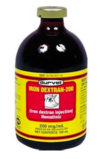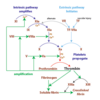Drugs Acting on the Blood Flashcards
What are the 4 different categories of drugs acting on the blood?
- Antianemic drugs
- Colony stimulating factors
- Drugs affecting hemostasis
- Treatment of thromboembolism in cats
Drugs affecting hemostasis can be broken up into drugs that affect __________ or __________.
Bleeding/hemorrhage or thrombosis/anti-thrombotic drugs.
What are the 2 major categories of anemia?
Hypoproliferative and Hyperproliferative.
What are the major type(s) of hypoproliferative anemia?
- Microcytic
- Normocytic
- Macrocytic
What are the major type(s) of hyperproliferative anemia?
Hemolytic
What are some causes of microcytic anemia?
- Iron or Copper deficiency
- Anemia of a chronic disease
- Sideroblastic anemia
What are some causes of normocytic anemia?
- Anemia of chronic disease
- Endocrine anemia
- Bone marrow failure
What are some causes of macrocytic anemia?
- Vitamin B12 deficiency
- Folic acid deficiency
- Myelodysplastic syndrome
What are some causes of hemolytic anemia?
- Hemoglobinopathies
- Autoimmune
- Membrane disorder
- Drug-induced
- Metabolic abnormalities
- Glucose-6-phosphate
- Dehydrogenase deficiency
- Infections
What is another name for microcytic anemia?
Hypochromic anemia
If you have microcytic anemia that is being caused by an iron deficiency, what would you use to treat it with?
Iron preparations: either parenteral or oral.
Why does iron deficiency cause anemia?
Because iron is a compoenent of the pigment called heme that is a component of hemoglobin which is a component of RBC’s.
If a pet has microcytic anemia due to copper deficency what can be done to treat it?
Copper preparations: parenteral or oral.
Why does copper deficiency cause anemia?
Copper is important for absorption and metabolism of iron. If Iron is not being absorbed, then as stated earlier you will have anemia because it is part of heme and heme is part of hemoglobin and hemoglobin is part of RBC’s. Also, copper is a part of cytochrome C oxidase.
What 2 species are normally affected by microcytic anemia?
Dogs (usually due to dietary copper or iron deficiency)
and
Pigs (they are born iron deficient and normally will acquire by ingesting soil.)
Parenteral iron preparations are normally mixed with what?
What is the significance of this?
Carbohydrate complexes: these are large molecules that are antigenic and cause histamine release and hypersensitivity; this is one of the major adverse effects.
ex: Iron Dextran

What is the best parenteral route to give iron?
Not IV due to hypersensitivity!!!
IM or SQ are preferred although it can cause pain on injection and a yellowish brown discoloration at the site of injection.
Heavy metals like Iron can be _______ or _______.
Organic (carbon and hydrogen) or Inorganic (where the valency is important: *oxidative state.*)
Heavy metals are astringents meaning what?
They can precipitate proteins which can cause constipation.
Some major side effecs of both the parenteral and oral iron preparations are what?
Vomiting, diarrhea, corosion of the GI tract, ulcers, bloody stools.
Specific antidotes for iron toxicity are what?
Chelating agents: these are drugs that when absorbed systemically, bind to the metal to form a complex or “chelate” which is a less toxic or non-toxic form and is water soluble and readily secreted in urine.
T/F: When giving an oral iron preparation is better to use an inorganic form.
False, it is better to use organic.
In a microcytic anemia emergency due to iron deficiency you would give what?
Parenteral iron preparation: quicker acting.
In a microcytic anemia stable patient with iron deficiency, you would use what?
Oral iron preparation.
Because most animals don’t have a way of eliminating iron from the body, care must be taken why?
Can easily cause adverse effects or overdose.
What is needed for iron to be transported throughout the body?
Carrier protein
What is another name for macrocytic anemia?
Megaloblastic anemia
Macrocytic anemia is generally associated with what?
Normally seen in ruminants (cattle) with cobalt deficiency. Cobalt deficiency leads to Vitamin B12 deficiency.
Signs of cobalt deficiency include weight loss, muscle wasting, depraved appetite, anemia and eventually death.
Anemia due to CRF (chronic renal failure) causes what?
A decreased output of erythropoieten and therefore a decrease in the # of RBCs produced.
What can cause bone marrow suppression?
Chemotherapy (not limited to anti-cancer drugs) can also include, anti-bacterials, anti-virals, anti-fungals etc. etc….
The bone marrow is normally where erythropoeisis takes place.
How would you treat anemia where there is a decreased prodution of erythropoieten?
What is a major side effect of the drug used to treat this type of anemia?
EPO/Epogen: this is synthetic erythropoieten given parenterally.
Side effects: vasoconstriction and hypertension.
With IMHA (Immune Mediate Hemolytic Anemia) which is a type of hyperproliferative anemia, what would the treatment be for that?
- Supportive treatment: Fluid therapy, Acid-base balance, and organ perfusion.
- Blood transfusion (in emergency situation)
What are some examples of immunosuppressents that are used to treat a hyperactive immune system causing hemolytic anemia?
- Glucocorticoids (Prednisone, Prednisolone)
- Cytotoxic drugs (Azathioprine~injectable, Cyclophosphamide)
- Danazol
- Cyclosporin A (capsules)
- IV γ globulin
What are colony stimulating factors?
Aka growth factors.
Used to treat and prevent neutropenia due to anti-cancer drugs.
What are the 2 types of colony stimulating factors?
G-CSF (Granulocyte colony stimulating factor)
and
GM-CSF (Granulocyte-macrophage colony stimulating factor)






